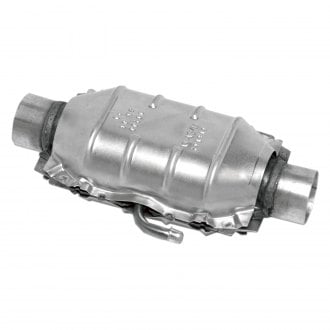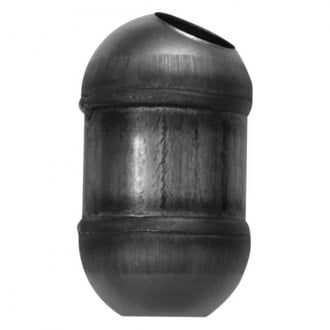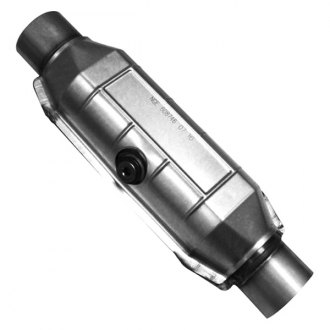Genesis Catalytic Converters

-
 Fel-Pro®Catalytic Converter GasketsCatalytic Converter Gaskets by Fel-Pro®. If you need durable gaskets to prevent leaks on your vehicle, Fel-Pro is the way to go. Engineered using the latest technologies and global engineering resources, the gaskets meet specific OEM...Direct OEM replacement for a proper fitEnsures reliable sealing performance$3.93 - $59.09
Fel-Pro®Catalytic Converter GasketsCatalytic Converter Gaskets by Fel-Pro®. If you need durable gaskets to prevent leaks on your vehicle, Fel-Pro is the way to go. Engineered using the latest technologies and global engineering resources, the gaskets meet specific OEM...Direct OEM replacement for a proper fitEnsures reliable sealing performance$3.93 - $59.09 -
 HJS®Catalytic Converter GasketCatalytic Converter Gasket by HJS®. This product is made of high-quality materials to serve you for years to come. Designed using state-of-the-art technology and with customers in mind. It will meet your needs and deliver great quality...High quality at an affordable priceExpertly made from premium materials$2.57 - $31.66
HJS®Catalytic Converter GasketCatalytic Converter Gasket by HJS®. This product is made of high-quality materials to serve you for years to come. Designed using state-of-the-art technology and with customers in mind. It will meet your needs and deliver great quality...High quality at an affordable priceExpertly made from premium materials$2.57 - $31.66 -
 Walker®Ultra™ Universal Fit Catalytic ConverterUniversal Ultra™ Catalytic Converter by Walker®. Converter Configuration: Universal Fit. This part features the correct load of precious metals to ensure the proper limitation of tailpipe emissions. It meets the EPA policy and...$111.92 - $330.87
Walker®Ultra™ Universal Fit Catalytic ConverterUniversal Ultra™ Catalytic Converter by Walker®. Converter Configuration: Universal Fit. This part features the correct load of precious metals to ensure the proper limitation of tailpipe emissions. It meets the EPA policy and...$111.92 - $330.87 -
 Torxe™Universal Fit Catalytic ConverterUniversal Catalytic Converter by Torxe™. Converter Configuration: Universal Fit. Catalytic Inlet Diameter: 2". Universal Fit Catalytic Converter by Torxe. Replace your clogged, corroded, and malfunctioning catalytic converter for the...$108.00 - $175.00
Torxe™Universal Fit Catalytic ConverterUniversal Catalytic Converter by Torxe™. Converter Configuration: Universal Fit. Catalytic Inlet Diameter: 2". Universal Fit Catalytic Converter by Torxe. Replace your clogged, corroded, and malfunctioning catalytic converter for the...$108.00 - $175.00 -
 AP Exhaust®608 Series Universal Fit Catalytic ConverterUniversal 608 Series Catalytic Converter by AP Exhaust®. Converter Configuration: Universal Fit. Without Air Tube. Today’s exhaust performance market continues to cover a broad spectrum of vehicles. The unique nature of this market is...$104.68 - $415.87
AP Exhaust®608 Series Universal Fit Catalytic ConverterUniversal 608 Series Catalytic Converter by AP Exhaust®. Converter Configuration: Universal Fit. Without Air Tube. Today’s exhaust performance market continues to cover a broad spectrum of vehicles. The unique nature of this market is...$104.68 - $415.87 -
 AP Exhaust®Enhanced Standard Duty Universal Fit Oval Body Catalytic ConverterUniversal Enhanced Standard Duty Catalytic Converter by AP Exhaust®. Converter Configuration: Universal Fit. Catalytic Converter Body Shape: Oval. Without O2 Sensor Port. Catalytic Converter Overall Length: 16". Today’s exhaust...$90.57 - $125.57
AP Exhaust®Enhanced Standard Duty Universal Fit Oval Body Catalytic ConverterUniversal Enhanced Standard Duty Catalytic Converter by AP Exhaust®. Converter Configuration: Universal Fit. Catalytic Converter Body Shape: Oval. Without O2 Sensor Port. Catalytic Converter Overall Length: 16". Today’s exhaust...$90.57 - $125.57 -
 AP Exhaust®Medium Duty Universal Fit Oval Body Catalytic ConverterUniversal Medium Duty Catalytic Converter by AP Exhaust®. Converter Configuration: Universal Fit. Catalytic Converter Body Shape: Oval. With Single Air Tube. With 1 Center O2 Sensor Port. Catalytic Converter Overall Length: 17"....$140.56
AP Exhaust®Medium Duty Universal Fit Oval Body Catalytic ConverterUniversal Medium Duty Catalytic Converter by AP Exhaust®. Converter Configuration: Universal Fit. Catalytic Converter Body Shape: Oval. With Single Air Tube. With 1 Center O2 Sensor Port. Catalytic Converter Overall Length: 17"....$140.56 -
 AP Exhaust®Standard Duty Spun Body Universal Fit Round Body Catalytic ConverterUniversal Standard Duty Spun Body Catalytic Converter by AP Exhaust®. Converter Configuration: Universal Fit. Catalytic Converter Body Shape: Round. Without Air Tube. Without O2 Sensor Port. Today’s exhaust performance market...$101.22 - $250.00
AP Exhaust®Standard Duty Spun Body Universal Fit Round Body Catalytic ConverterUniversal Standard Duty Spun Body Catalytic Converter by AP Exhaust®. Converter Configuration: Universal Fit. Catalytic Converter Body Shape: Round. Without Air Tube. Without O2 Sensor Port. Today’s exhaust performance market...$101.22 - $250.00 -
 AP Exhaust®Universal Fit Round Body Catalytic ConverterUniversal Catalytic Converter by AP Exhaust®. Converter Configuration: Universal Fit. Catalytic Converter Body Shape: Round. Without Air Tube. Today’s exhaust performance market continues to cover a broad spectrum of vehicles. The...$232.31 - $339.18
AP Exhaust®Universal Fit Round Body Catalytic ConverterUniversal Catalytic Converter by AP Exhaust®. Converter Configuration: Universal Fit. Catalytic Converter Body Shape: Round. Without Air Tube. Today’s exhaust performance market continues to cover a broad spectrum of vehicles. The...$232.31 - $339.18 -
 Davico®OBDII Universal Fit Catalytic ConverterUniversal OBDII Catalytic Converter by Davico®. Converter Configuration: Universal Fit. This Universal fit catalytic converter by Davico will be a great solution to replace your failed or damaged catalytic converter. Once your stock cat...$115.32 - $765.46
Davico®OBDII Universal Fit Catalytic ConverterUniversal OBDII Catalytic Converter by Davico®. Converter Configuration: Universal Fit. This Universal fit catalytic converter by Davico will be a great solution to replace your failed or damaged catalytic converter. Once your stock cat...$115.32 - $765.46 -
 CATCO®Universal Fit Catalytic ConverterUniversal Catalytic Converter by CATCO®. Converter Configuration: Universal Fit. Without Air Tube. Designed and manufactured with innovative fabrication methods, high-tech materials, and advanced coating, this converter leapfrogs the...$128.47 - $250.13
CATCO®Universal Fit Catalytic ConverterUniversal Catalytic Converter by CATCO®. Converter Configuration: Universal Fit. Without Air Tube. Designed and manufactured with innovative fabrication methods, high-tech materials, and advanced coating, this converter leapfrogs the...$128.47 - $250.13 -
 Eastern Catalytic®Universal Fit Large Oval Body Catalytic ConverterUniversal Catalytic Converter by Eastern Catalytic®. Converter Configuration: Universal Fit. Catalytic Converter Body Shape: Large Oval. Catalytic Converter Overall Length: 16". Whether your catalytic converter is damaged by road debris...$175.93 - $259.76
Eastern Catalytic®Universal Fit Large Oval Body Catalytic ConverterUniversal Catalytic Converter by Eastern Catalytic®. Converter Configuration: Universal Fit. Catalytic Converter Body Shape: Large Oval. Catalytic Converter Overall Length: 16". Whether your catalytic converter is damaged by road debris...$175.93 - $259.76 -
 Eastern Catalytic®Universal Fit Oval Body Catalytic ConverterUniversal Catalytic Converter by Eastern Catalytic®. Converter Configuration: Universal Fit. Catalytic Converter Body Shape: Oval. Whether your catalytic converter is damaged by road debris or failed due to an engine problem, you...$120.09 - $190.63
Eastern Catalytic®Universal Fit Oval Body Catalytic ConverterUniversal Catalytic Converter by Eastern Catalytic®. Converter Configuration: Universal Fit. Catalytic Converter Body Shape: Oval. Whether your catalytic converter is damaged by road debris or failed due to an engine problem, you...$120.09 - $190.63 -
 Eastern Catalytic®Universal Fit Round Body Catalytic ConverterUniversal Catalytic Converter by Eastern Catalytic®. Converter Configuration: Universal Fit. Catalytic Converter Body Shape: Round. Whether your catalytic converter is damaged by road debris or failed due to an engine problem, you...$151.91 - $181.15
Eastern Catalytic®Universal Fit Round Body Catalytic ConverterUniversal Catalytic Converter by Eastern Catalytic®. Converter Configuration: Universal Fit. Catalytic Converter Body Shape: Round. Whether your catalytic converter is damaged by road debris or failed due to an engine problem, you...$151.91 - $181.15 -
 Eastern Catalytic®Universal Fit Round Body Catalytic ConverterUniversal Catalytic Converter by Eastern Catalytic®. Converter Configuration: Universal Fit. Catalytic Converter Body Shape: Round. Contains approximately 40% higher precious metal content than most other aftermarket brands. Aristo...$360.90 - $462.25
Eastern Catalytic®Universal Fit Round Body Catalytic ConverterUniversal Catalytic Converter by Eastern Catalytic®. Converter Configuration: Universal Fit. Catalytic Converter Body Shape: Round. Contains approximately 40% higher precious metal content than most other aftermarket brands. Aristo...$360.90 - $462.25 -
 Genesis OEFront Exhaust Pipe Flange Gasket (287513J000)Front Exhaust Pipe Flange Gasket (287513J000) by Genesis OE. If you crave to keep your Genesis running in tip-top shape, use only genuine replacement parts from Genesis OE. Meticulously crafted to the highest quality standards and exact...Genuine OE replacement for your worn out Genesis partGuaranteed to get your vehicle back to its original look and feel$24.26
Genesis OEFront Exhaust Pipe Flange Gasket (287513J000)Front Exhaust Pipe Flange Gasket (287513J000) by Genesis OE. If you crave to keep your Genesis running in tip-top shape, use only genuine replacement parts from Genesis OE. Meticulously crafted to the highest quality standards and exact...Genuine OE replacement for your worn out Genesis partGuaranteed to get your vehicle back to its original look and feel$24.26 -
 Genesis OERear Exhaust Muffler Gasket (287513S100)Rear Exhaust Muffler Gasket (287513S100) by Genesis OE. If you crave to keep your Genesis running in tip-top shape, use only genuine replacement parts from Genesis OE. Meticulously crafted to the highest quality standards and exact...Genuine OE replacement for your worn out Genesis partGuaranteed to get your vehicle back to its original look and feel$25.47
Genesis OERear Exhaust Muffler Gasket (287513S100)Rear Exhaust Muffler Gasket (287513S100) by Genesis OE. If you crave to keep your Genesis running in tip-top shape, use only genuine replacement parts from Genesis OE. Meticulously crafted to the highest quality standards and exact...Genuine OE replacement for your worn out Genesis partGuaranteed to get your vehicle back to its original look and feel$25.47 -
 Fel-Pro®Exhaust Pipe Connector Gasket (W0133-2329110-FEL)Exhaust Pipe Connector Gasket (W0133-2329110-FEL) by Fel-Pro®. If you need durable gaskets to prevent leaks on your vehicle, Fel-Pro is the way to go. Engineered using the latest technologies and global engineering resources, the...Direct OEM replacement for a proper fitEnsures reliable sealing performance$12.08
Fel-Pro®Exhaust Pipe Connector Gasket (W0133-2329110-FEL)Exhaust Pipe Connector Gasket (W0133-2329110-FEL) by Fel-Pro®. If you need durable gaskets to prevent leaks on your vehicle, Fel-Pro is the way to go. Engineered using the latest technologies and global engineering resources, the...Direct OEM replacement for a proper fitEnsures reliable sealing performance$12.08 -
 Fel-Pro®Exhaust Pipe Connector Gasket (W0133-2321943-FEL)Exhaust Pipe Connector Gasket (W0133-2321943-FEL) by Fel-Pro®. If you need durable gaskets to prevent leaks on your vehicle, Fel-Pro is the way to go. Engineered using the latest technologies and global engineering resources, the...Direct OEM replacement for a proper fitEnsures reliable sealing performance$11.50
Fel-Pro®Exhaust Pipe Connector Gasket (W0133-2321943-FEL)Exhaust Pipe Connector Gasket (W0133-2321943-FEL) by Fel-Pro®. If you need durable gaskets to prevent leaks on your vehicle, Fel-Pro is the way to go. Engineered using the latest technologies and global engineering resources, the...Direct OEM replacement for a proper fitEnsures reliable sealing performance$11.50 -
 Mahle®Exhaust Pipe Connector Gasket (W0133-1901757-MAH)Exhaust Pipe Connector Gasket (W0133-1901757-MAH) by Mahle®. This product is made of high-quality materials to serve you for years to come. Designed using state-of-the-art technology and with customers in mind. It will meet your needs...High quality at an affordable priceExpertly made from premium materials$8.64
Mahle®Exhaust Pipe Connector Gasket (W0133-1901757-MAH)Exhaust Pipe Connector Gasket (W0133-1901757-MAH) by Mahle®. This product is made of high-quality materials to serve you for years to come. Designed using state-of-the-art technology and with customers in mind. It will meet your needs...High quality at an affordable priceExpertly made from premium materials$8.64 -
 HJS®Catalytic Converter Gasket (W0133-1917939-HJS)Catalytic Converter Gasket (W0133-1917939-HJS) by HJS®. Position: Rear Forward. This product is made of high-quality materials to serve you for years to come. Designed using state-of-the-art technology and with customers in mind. It...High quality at an affordable priceExpertly made from premium materials$8.06
HJS®Catalytic Converter Gasket (W0133-1917939-HJS)Catalytic Converter Gasket (W0133-1917939-HJS) by HJS®. Position: Rear Forward. This product is made of high-quality materials to serve you for years to come. Designed using state-of-the-art technology and with customers in mind. It...High quality at an affordable priceExpertly made from premium materials$8.06 -
 Fel-Pro®Exhaust Pipe Connector Gasket (W0133-2324893-FEL)Exhaust Pipe Connector Gasket (W0133-2324893-FEL) by Fel-Pro®. If you need durable gaskets to prevent leaks on your vehicle, Fel-Pro is the way to go. Engineered using the latest technologies and global engineering resources, the...Direct OEM replacement for a proper fitEnsures reliable sealing performance$9.06
Fel-Pro®Exhaust Pipe Connector Gasket (W0133-2324893-FEL)Exhaust Pipe Connector Gasket (W0133-2324893-FEL) by Fel-Pro®. If you need durable gaskets to prevent leaks on your vehicle, Fel-Pro is the way to go. Engineered using the latest technologies and global engineering resources, the...Direct OEM replacement for a proper fitEnsures reliable sealing performance$9.06 -
 Walker®Ultra™ Universal Fit Round Body Catalytic Converter (13" Length) (15104)Universal Ultra™ Catalytic Converter (15104) by Walker®. Converter Configuration: Universal Fit. Catalytic Converter Body Shape: Round. Without Air Tube. With O2 Sensor Port. Catalytic Converter Overall Length: 17.5". This part...$330.87
Walker®Ultra™ Universal Fit Round Body Catalytic Converter (13" Length) (15104)Universal Ultra™ Catalytic Converter (15104) by Walker®. Converter Configuration: Universal Fit. Catalytic Converter Body Shape: Round. Without Air Tube. With O2 Sensor Port. Catalytic Converter Overall Length: 17.5". This part...$330.87 -
 Walker®Ultra™ Universal Fit Small Oval Body Catalytic Converter (10" Length) (15039)Universal Ultra™ Catalytic Converter (15039) by Walker®. Converter Configuration: Universal Fit. Catalytic Converter Body Shape: Small Oval. Without Air Tube. Without O2 Sensor Port. Catalytic Converter Overall Length: 13.25". This...$136.37
Walker®Ultra™ Universal Fit Small Oval Body Catalytic Converter (10" Length) (15039)Universal Ultra™ Catalytic Converter (15039) by Walker®. Converter Configuration: Universal Fit. Catalytic Converter Body Shape: Small Oval. Without Air Tube. Without O2 Sensor Port. Catalytic Converter Overall Length: 13.25". This...$136.37 -
 Walker®Ultra™ Universal Fit Small Oval Body Catalytic Converter (10" Length) (15034)Universal Ultra™ Catalytic Converter (15034) by Walker®. Converter Configuration: Universal Fit. Catalytic Converter Body Shape: Small Oval. With Air Tube. Without O2 Sensor Port. Catalytic Converter Overall Length: 13.25". This part...$130.16
Walker®Ultra™ Universal Fit Small Oval Body Catalytic Converter (10" Length) (15034)Universal Ultra™ Catalytic Converter (15034) by Walker®. Converter Configuration: Universal Fit. Catalytic Converter Body Shape: Small Oval. With Air Tube. Without O2 Sensor Port. Catalytic Converter Overall Length: 13.25". This part...$130.16 -
 Torxe™Universal Fit Oval Body Catalytic Converter (2" ID, 2" OD) (79-1002202)Universal Catalytic Converter (79-1002202) by Torxe™. Converter Configuration: Universal Fit. Catalytic Converter Body Shape: Oval. Catalytic Inlet Diameter: 2". Catalytic Outlet Diameter: 2". Catalytic Converter Overall Length: 15"....$175.00
Torxe™Universal Fit Oval Body Catalytic Converter (2" ID, 2" OD) (79-1002202)Universal Catalytic Converter (79-1002202) by Torxe™. Converter Configuration: Universal Fit. Catalytic Converter Body Shape: Oval. Catalytic Inlet Diameter: 2". Catalytic Outlet Diameter: 2". Catalytic Converter Overall Length: 15"....$175.00 -
 Torxe™Universal Fit Oval Body Catalytic Converter (2" ID, 2.25" OD) (79-1002204)Universal Catalytic Converter (79-1002204) by Torxe™. Converter Configuration: Universal Fit. Catalytic Converter Body Shape: Oval. With Dual Inlet. Catalytic Inlet Diameter: 2". Catalytic Outlet Diameter: 2.25". Catalytic Converter...$147.50
Torxe™Universal Fit Oval Body Catalytic Converter (2" ID, 2.25" OD) (79-1002204)Universal Catalytic Converter (79-1002204) by Torxe™. Converter Configuration: Universal Fit. Catalytic Converter Body Shape: Oval. With Dual Inlet. Catalytic Inlet Diameter: 2". Catalytic Outlet Diameter: 2.25". Catalytic Converter...$147.50 -
 Torxe™Universal Fit Round Body Catalytic Converter (2" ID, 2" OD) (79-1002201)Universal Catalytic Converter (79-1002201) by Torxe™. Converter Configuration: Universal Fit. Catalytic Converter Body Shape: Round. Catalytic Inlet Diameter: 2". Catalytic Outlet Diameter: 2". Catalytic Converter Overall Length: 11"....$114.00
Torxe™Universal Fit Round Body Catalytic Converter (2" ID, 2" OD) (79-1002201)Universal Catalytic Converter (79-1002201) by Torxe™. Converter Configuration: Universal Fit. Catalytic Converter Body Shape: Round. Catalytic Inlet Diameter: 2". Catalytic Outlet Diameter: 2". Catalytic Converter Overall Length: 11"....$114.00 -
 Torxe™Universal Fit Round Body Catalytic Converter (2" ID, 2" OD) (79-1002203)Universal Catalytic Converter (79-1002203) by Torxe™. Converter Configuration: Universal Fit. Catalytic Converter Body Shape: Round. Catalytic Inlet Diameter: 2". Catalytic Outlet Diameter: 2". Catalytic Converter Overall Length: 7.5"....$108.00
Torxe™Universal Fit Round Body Catalytic Converter (2" ID, 2" OD) (79-1002203)Universal Catalytic Converter (79-1002203) by Torxe™. Converter Configuration: Universal Fit. Catalytic Converter Body Shape: Round. Catalytic Inlet Diameter: 2". Catalytic Outlet Diameter: 2". Catalytic Converter Overall Length: 7.5"....$108.00 -
 AP Exhaust®608 Series No Neck Style Universal Fit Round Body Catalytic Converter (2" ID, 2" OD) (608364)Universal 608 Series No Neck Style Catalytic Converter (608364) by AP Exhaust®. Converter Configuration: Universal Fit. Catalytic Converter Body Shape: Round. Without Air Tube. Without O2 Sensor Port. Catalytic Inlet Diameter: 2"....$104.68
AP Exhaust®608 Series No Neck Style Universal Fit Round Body Catalytic Converter (2" ID, 2" OD) (608364)Universal 608 Series No Neck Style Catalytic Converter (608364) by AP Exhaust®. Converter Configuration: Universal Fit. Catalytic Converter Body Shape: Round. Without Air Tube. Without O2 Sensor Port. Catalytic Inlet Diameter: 2"....$104.68
Shop By Service Type
The Genesis catalytic converter (AKA catcon or cat) was first introduced in the mid-70's, and back then, it performed only two tasks, which is exactly why it was called a two-way converter. It oxidized carbon monoxide to carbon dioxide and hydrocarbons to water and carbon dioxide (oxidation stage). In 1981, the two-way converter was replaced by a much more efficient three-way catcon, which additionally reduced nitrogen oxide emissions (reduction stage).
Today, the two-way version is used in diesel applications only, while most vehicles are equipped with a three-way catalytic converter. Located between the engine and muffler, the converter actually resembles a muffler in shape, though the construction of these two units is completely different. The body of the converter is usually made of stainless steel. Inside the body, you'll find an insulated chamber, which contains three main components of any converter: substrate (or catalyst core), washcoat, and catalyst.
The catalyst core usually has a honeycomb structure, and it's most often a ceramic monolith. Basically, it serves as a support for the washcoat. The washcoat itself is a carrier for the catalytic materials. Materials for the washcoat are chosen to form an irregular surface, which maximizes the catalytically active layer available to react with the exhaust gases. And then comes the catalyst, which is most ofter a mixture of precious metals such as palladium (oxidation catalyst) and rhodium (reduction catalyst). When the exhaust stream passes through the converter, it contacts with the catalyst and all the toxic elements covert into the harmless substances. The leaving gas is monitored by the control system to make sure it meets the emissions requirements.








































